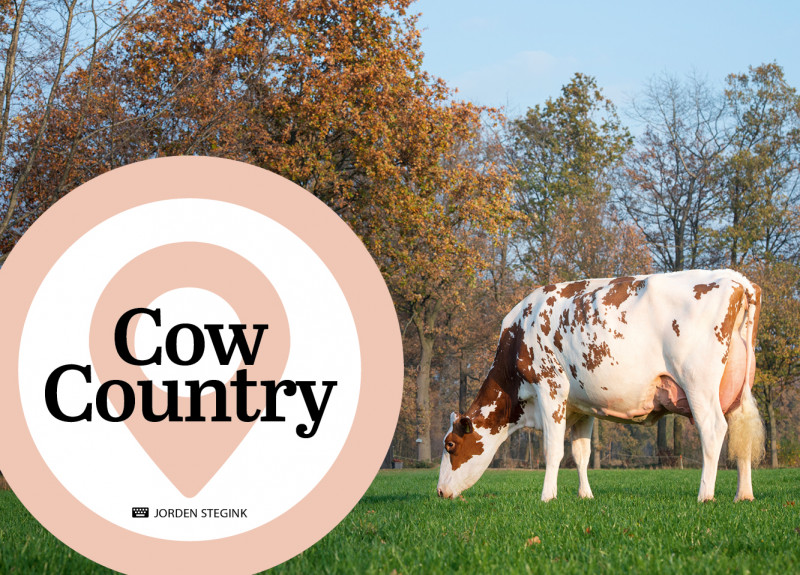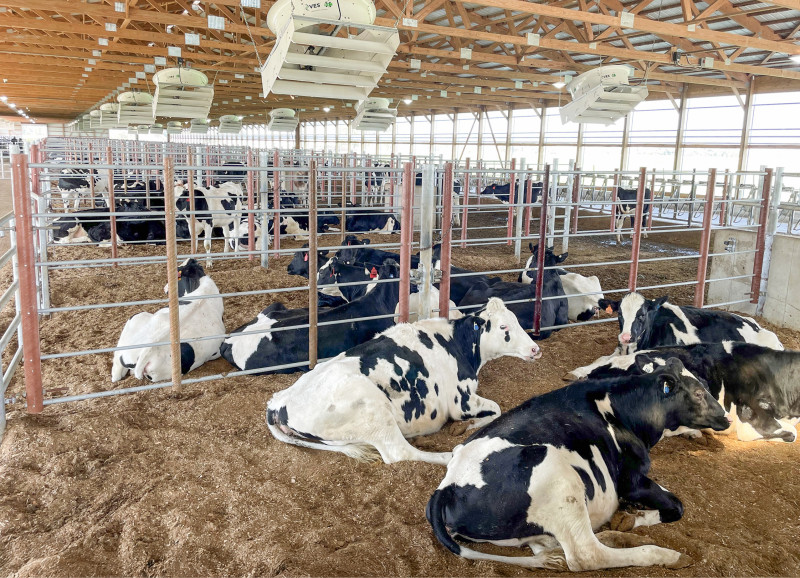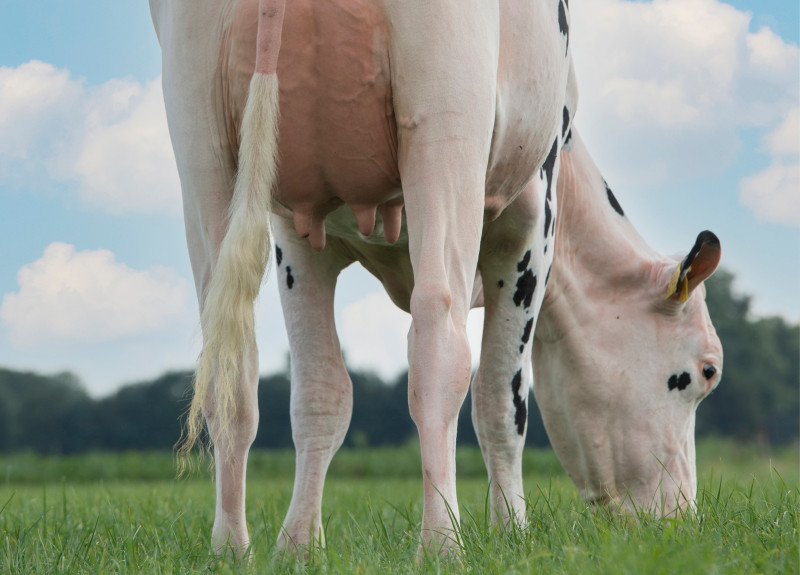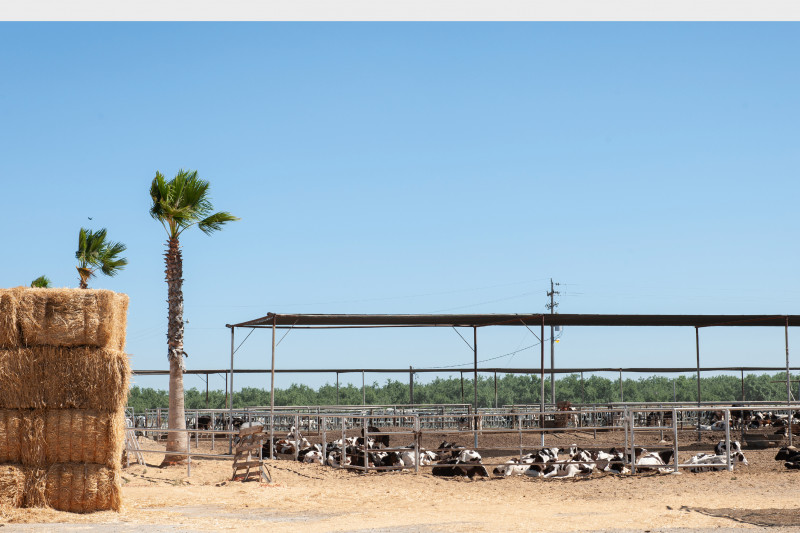
Pioneers when it comes to ET and OPU/IVF: In four decades, the herds at Ruann and Maddox Dairy in California have produced nearly 150,000 embryos.’
Fifty years ago, on March 12, 1974, the world’s first Holstein ET calf was born. This bull calf, named Rockalli Son of Bova, marks the starting shot of the enormous influence of the reproductive technique ET (Embryo Transplantation) on the development of the Holstein breed. Also having a large impact is the breakthrough this century of the OPU/IVF (Ovum Pick-Up/In Vitro Fertilisation) technique. HI investigates the possibilities of ET and OPU/IVF in 2024. Not only in elite breeding, but precisely also as a management instrument on dairy farms.
JORDEN STEGINK, HAN HOPMAN & CHRISTINE MASSFELLER
Northern England, 1890: Scientist Walter Heape places recently fertilized eggs from an Angora rabbit into a Belgian hare recipient. Successfully, as becomes evident when the Belgian hare irrefutably gives birth to Angora offspring. Heape’s revolutionary experiment turned out to be of inestimable significance for Holstein breeding. This is displayed, for example, on the gTPI list from Holstein USA. All 200 sires on the ranking, without exception, were bred via ET or OPU/IVF.
RUANN/MADDOX
Bova, the world’s first Holstein ET calf and a subsequent foundation sire of Manfred and O-Man, was born in the American state of Washington.1,250 miles/2,000 km further south, in California, we find Ruann and Maddox Dairy; two dairy farms with a rich ET and OPU/IVF history. ‘We produce 4,000-5,000 embryos a year from our donors. In total, we are probably at 150,000. At our lab we also do custom ET work for a variety of breeders, which amounts to another 5,000 embryos a year.’ Pat Maddox explains successive developments on behalf of the family farm: ‘In 1978 my father Doug offered several of our cows for an ET demonstration. By 1980, our local veterinarian Dr. Bob Cutright had learned the procedure and we started flushing our best cows. A few years later, Em Tran had a mobile ET service team with Dr. Ken Halbach in California. We used both ET services as we ramped up our ET program. In 1983 we built an ET facility with indoor flush chute and a search room and two years later we hired Dr. Halbach full-time to head up our ET program. We did a little IVF in the mid-90s with an embryologist from South Africa. After he left, we only did conventional flushes until Dr. Halbach left and we hired Dr. Daniela Demetrio, recognized as one of the elite IVF embryologists, in 2006. At that time, we added an embryo lab for more IVF. We did both flush and IVF for a few years until we went entirely IVF, except when needed for an export order.’
MORE MILK
The progressive ET and IVF adoption at Ruann and Maddox Dairy (5,500 milking cows combined) coincides with a progressive breeding philosophy. Maddox: ‘My father saw right away the possibilities with ET as a breeder. Like all breeders, you always want more offspring from your best cows. We soon realized that certain cow families were prolific and greatly increased genetic progress. It led to many more EX cows, more multiple generation EX, and some greatly expanded cow families. Around 2000 we found that five families were very prolific, each having from 180 to 300 females in our herds. The Merlas known for high milk, the Glorys for high type and many EX, the Taunas for great udders, the Dorindas for show ring type, the Posch family for high indexes. Currently we have some elite donors that we continue to work with because their offspring are so desirable. Uno Posch-25282 has over 160 offspring, Shamrock Anna-11201 has 88. Sidney Jean-85880 has 72 (> 20 EX), including EX-95 Doorman Jean. Punch Norain-26484 has 127 that lead to some of our highest genomic heifers.’
The progressive use of ET and IVF transformed the herds. ‘In 1980 at Ruann we had 800 milking cows and only half were registered. We built Maddox dairy in 1982 with a capacity of 3,200 milking. Most of the cows we purchased were grade Holsteins, so we started by putting the ET transfers into the grades and then into all lower pedigreed cows. By 1996 all 4,500 milking cows were registered. A study we did in 1992 showed that ET offspring not only had more elite type, but also averaged +4000 lb/1800 kg milk over herd mates.’ About its influence on marketing, Maddox explains. ‘We specialize in larger orders and have exported to over 35 countries. With our herd we can meet just about any specificities or embryo type they can come up with. We breed for the show ring, B&W and R&W, high genomics, TPI, PTAT/type and polled. We currently have the highest gPTAT heifer and highest Red in the US as of the 12/23 proof.’
AURORA
Aurora Ridge Dairy in the American state of New York has 2,650 milking cows. Herdsman David Harvatine: ‘ET was used in the past to potentially produce bulls for AI and future donors. Now, with a good amount of IVF, it’s used to create as many replacements out of our top females along with some bulls for AI. Our current site is at its upper capacity, so therefore the goal is to fill every stall with the highest genetic cow possible. The families represented in our donors and high females have proven their excellence to us and therefore we want to multiply and magnify their presence in the herd. Currently we have seventeen heifers housed in central Pennsylvania at a Boviteq satellite facility. We normally have twelve to fifteen donors in the IVF routine every two weeks. I like being able to do IVF every two weeks and maximize the number of matings per donor. All resulting embryos are frozen. ET work is done if there is an embryo contract for export that requires conventional ET.’
Harvatine describes ET and IVF techniques as challenging. ‘It is stressful when the highest donor didn't make that many embryos, or you didn't make as many pregnancies as you had hoped. Focus on continual improvement and details can be tiring, but nothing refuels the tank like creating the next donor for the program.’
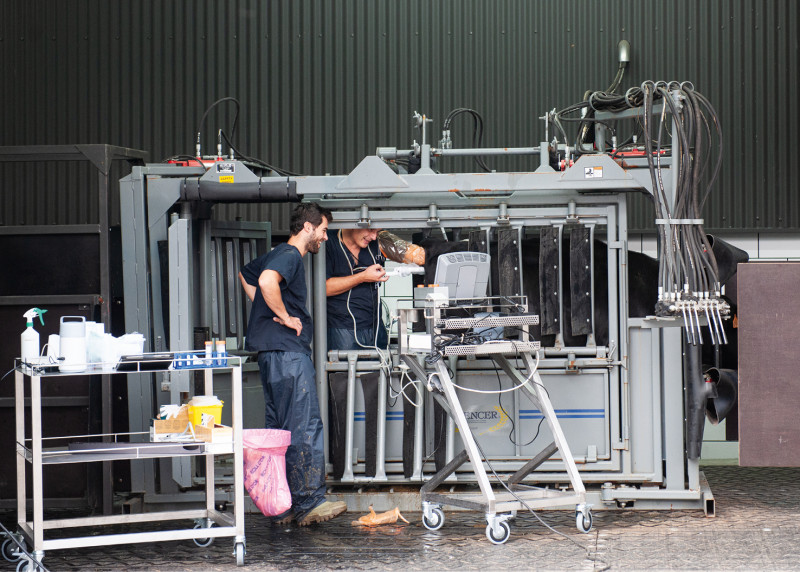
The OPU/IVP technique has taken flight in Holstein breeding this century.
Profitable
Harvatine recommends monitoring costs closely. ‘I track our costs monthly looking at what it costs to produce an embryo. We take advantage of pooling oocytes and I am quick to retire a donor from IVF if she is not hitting the mark with oocyte production. Still, I will always have the opinion that investment in genetics pays in a commercial herd. You can make respectable gains with sexed semen, but have the potential to make more with ET/IVF. I am always interested in being ahead of the curve versus trying to catch up.’ Passion for breeding, according to Harvatine, is a must. ‘First and foremost, you have to have a high level of interest in genetics. Genetics is my passion and it helps that there are others here that have the same passion and support it. Expenses can add up quickly, so you need to have a long-term plan and push ahead towards reaching your goals. It has been a process for me personally for over 23 years to get the herd to where it is today, yet I still keep pushing ideas in my head of where we can and need to go. Having the "right" genetics I think is due to staying focused on where we wanted to go vs jumping on the latest trends in genetic selection. There is also a need to accept when a mating doesn't work.’
Harvatine bred the successful TPI sire Aurora Mitchell. A female descendant at an absolute elite level is the five-year-old Aurora Rapid 21849 VG-85 (3014 gTPI). ‘Both the families behind Mitchell and Rapid 21849 have proven themselves in our herd. A large percentage of our current donors come from these bloodlines. Rapid 21849 recently calved for the second time. I am very proud of the fact that she's out being a cow with her top daughter Parfect 23719 GP-83, her dam Frazzled 19447 VG-87 and grandam Doorsopen 17054 EX-92. I want all of my donors to be in calf at fourteen to fifteen months of age and become part of the milking herd, since I feel the phenotypic performance is crucial to our success in the future.’
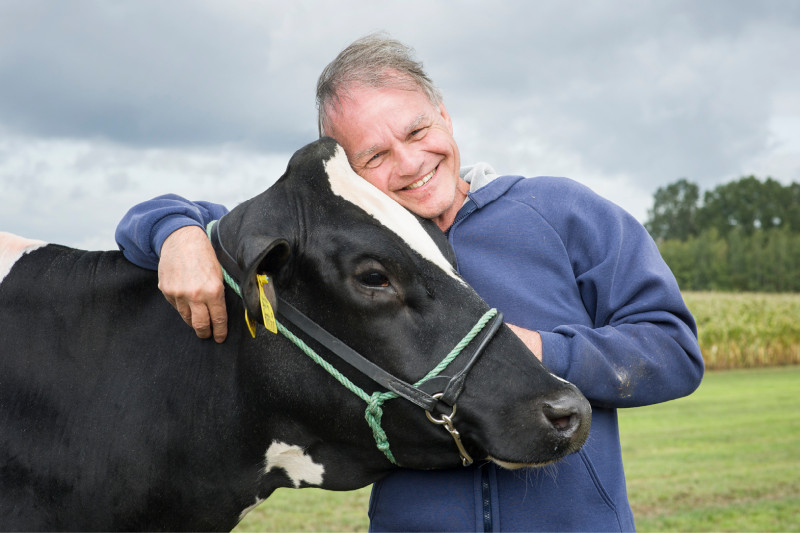
Bernd Sommer, the owner of Holstein Forum: ‘With ET, you can reach very nice results.’
PHENOMENAL
Dr. Aaron Prososki, just like his father Dr. John Prososki (WET Holsteins) trained as a veterinarian and specialized in ET, is the co-owner of Sunshine Genetics in Wisconsin. Sunshine Genetics provides housing for 350-400 donors, has a climate-controlled collection room, an in vivo laboratory, and an in-house IVF lab. Prososki: 'I would say approximately 80% of our work is performed in-house and 20% is at our clients’ farms. One of the largest advantages to housing donors at our facility is that we have full control over the donor and can manage them on an individual level to maximize success - intensively managed shot protocols, moving donors between conventional flushing and IVF, qualifying embryos for export, etc.'
According to Prososki, the use of IVF offers several advantages compared to ET. 'IVF can be performed on pre-pubertal and pregnant donors. In some situations, stimulation with FSH is not necessary or at least a much less intense dosage/shot program as compared to conventional flushing is utilized, and the ability to do the procedure every two weeks allows for a greater amount of diversity/selection of sires used. IVF embryo technology is always advancing and improving. Some of the disadvantages are that it is not uncommon for frozen IVF embryos to have lower performance than a frozen in vivo embryo in terms of conception rate - IVF embryos will also generally have more mid-gestational abortions, stillbirths, occasional large offspring syndrome, and though rare, genetic anomalies upon birth. It feels that in North America, or at least among Sunshine Genetics clientele, the majority of the IVF embryos are transferred fresh, and the conception rate of fresh IVF embryos is very acceptable.'
Prososki also shares some advice: 'I also always encourage anyone new to ET/IVF to focus on conventional flushing and recipient management first. Conventional flushing is more labor intensive from a management perspective but the in vivo embryo is much more stoic than an IVF embryo. Once, the foundational knowledge of advanced reproduction as a management tool has been established, proven success on recipient synchronization, comfort with conventional flushing, and thawing/transferring of embryos - then it would be time to add IVF as part of a program. IVF has a lot of nuances and can be a bit of a roller coaster of results for those without a good understanding. When used/managed correctly, IVF can be a phenomenal tool.'
ET AGAIN
‘ET has created a revolution in breeding. For the first time ever, the technique made it possible to breed a large number of descendants from genetically superior females. Since embryos are relatively simple to transport and export, this subsequently provided access to completely new markets.’ Speaking is Bernd Sommer, owner of the German marketing platform Holstein Forum. The intensive use of ET and now also OPU/IVF, according to Sommer, provides breeders and farmers with lots of opportunities in 2024. ‘During the past few years, especially in North America, the role of IVF has risen significantly. Every two weeks, embryos can be made in combination with other sires, embryos made from pregnant animals; the possibilities are virtually endless. Due to the strong development of ET and IVF, the genetic market has broadened enormously. Farmers who want to build up their herd, can today purchase plenty of embryos from elite, proven families for reasonable prices.’
Sommer appreciates the advantages of IVF, but also notes disadvantages. ‘IVF has by and large taken over the use of ET in North America. The secret to that success lies in keeping strictly confidential the composition of the media used by North American companies in laboratories for the maturing, fertilization, and growing of embryos. The quality of the European developed and used media for IVF is lower. That can lead to fewer embryos, pregnancies, and full-term calves, and more difficult births for calves, sometime weighing 60-70 kg/140-155 lb. That’s the reason why some commercial dairy farmers no longer offer recipients for the use of IVF embryos.’ According to Sommer, even if European companies had access to the best possible media for IVF, then he still wonders if this technique would become as prominent as it is in North America. ‘Large breeding programs in North America are proud when they breed an index leader with a twelve-month-old dam and a two-year-old grandam. The harvesting of eggs out of donors that are just a few months old is not a given in Europe. The dairy industry will likely not be able to sell that to society.’
As a breeder, Sommer has experience with IVF, but has now purposefully opted exclusively for ET. ‘With ET, you can reach very nice results. During the past period, we averaged eight to twelve embryos per flush; as such, I am very satisfied and well-served.’
‘I also always encourage anyone new to ET/IVF to focus on conventional flushing and recipient management first.’

Aurora Mitchell, a third generation ET from Aurora Ridge Dairy in New York.
DISCUSSIONS
In Denmark, Søren Ernst Madsen, together with his partner Elisabeth Ravnevand, operates the breeding enterprise Tirsvad Genetics (HI 12/23), as well as the ET and OPU/IVF service TransEmbryo. During past years, Madsen has witnessed significant developments. ‘ET continues to be a valuable technique, both for individual breeders and for large AIs. Some breeders prefer to use ET to breed better descendants for their own dairy herds, while others prefer to use IVF for pregnant show animals. Large AIs are using more and more IVF in centres that they have set up and monitor themselves. That is a global trend.’ Madsen himself is an OPU/IVF specialist. ‘IVF offers certain advantages, such as the use of pregnant animals and the possibility every two weeks of combining young donors with a different sire of sons. But IVF also has drawbacks/challenges, no matter the quality of the media. Growing embryos outside of a natural uterus always creates a larger chance of abortions during all stages of pregnancy, as well as calves that are born too large. And can we operate on young donors, only for the pursuit of the shortest possible generation interval? It is important as veterinarian professionals to recognize and discuss these themes and issues. And then, based on unbiased, knowledge, establish principals to guide us in how to proceed. This especially also from the knowledge that societies in western countries look over our shoulders and will not shy away from addressing the dairy industry about undesired welfare effects within cattle breeding.’
FANTASTIC HERDS
Mark Nutsford is an ET specialist for Celltech Embryo Transfer and the owner of the elite breeding enterprise Riverdane Holsteins (HI 07/23) in the UK. ‘ET and OPU/IVF can hardly be compared in terms of technique. In this respect, ET works better for me.’ When asked about the most important prerequisites for good ET results, he immediately mentions nutrition. ‘Feeding correctly for ET encompasses more than just a high energy, low protein ration alone. Also crucial are the amino acids methionine, lysine and leucine; they need to be present in the right ratio. When the flush results on a farm are disappointing, due to possible imperfections in the ration, we always consult with the local ration specialist. After all, this person has the most insight into the ration that is being used on the farm.’
Precisely on dairy farms that are well-managed with good forage harvesting and ration composition that is standard, the use of ET provides tremendous opportunities, according to Nutsford. ‘That one two-year-old produces 40 kg/88 lb and the other, based on the same ration, remains stuck at 28 kg/62 lb, displays the significant added value of good genetics. On farms that have methodically used the best genetic animals possible for ET, I see fantastic herds.’ l
50 YEARS OF IETS
1974 is the birth year of the world’s first Holstein ET calf, Rockalli Son of Bova. 1974 is also the founding year of International Embryo Technology Society. This association, or IETS in short, hosts a conference every year. ‘In January, we could welcome 600 of our total of 1,000 members at our anniversary conference. It was held in Denver, Colorado, the city where IETS was founded 50 years ago.’ Speaking is Rebecca Krisher, IETS President and employed as Global Senior Director of Reproductive Biology for Genus ABS. ‘Bringing ET and OPU/IVF specialists from all over the world together, sharing knowledge, discussing together, and in this way pursuing progress; that is why IETS was established.’ When asked about the specific topics discussed at the anniversary conference, Krisher comments: ‘They range from purely scientific to more practical applications. The first category includes the relationship between OPU/IVF and the CRISPR technique, also known as Gene Therapy. More geared to the field, for example, are discussions about the best management of donors and recipients. A new development that is being heavily researched involves uterine research with recipients. Not only by way of ultrasound technology, but in the future likely also via biopsy techniques, so that onsite and nearly instantly it can determined whether or not a recipient’s uterus is suitable to receive an embryo.’ Krisher mentions yet another gap in the market. ‘Due to the strong demand for OPU/IVF, there is a high demand for lab technicians. For high school and university students, there are nice career opportunities.’
